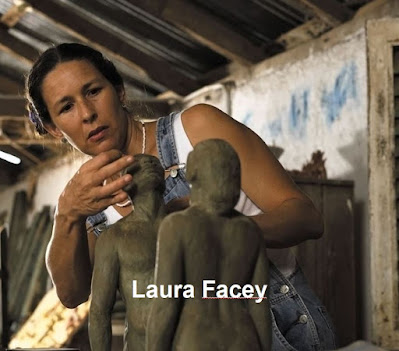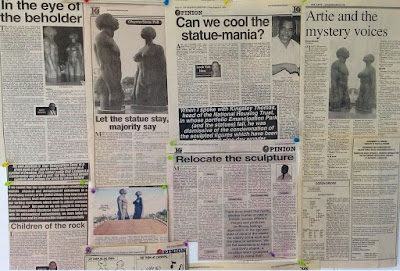April 17, 2021
The National Gallery of Jamaica Art – the Gem of the Caribbean
The National Gallery of Jamaica, established in 1974, is the oldest and largest public art museum in the Caribbean.
Jamaican art evolved into groups, “mainstream” and “intuitive” artists. “Mainstream” artists were trained and influenced by styles from abroad. The “intuitives” maintained strong relationship with African forms of expression, and had no formal training.
After centuries of colonial rule, Jamaica became independent from Britain on August 6, 1962. The next year the first touring art exhibition – Face of Jamaica – went to Europe and toured Germany and France for nine months between 1963 and 1964. The title Face of Jamaica allowed its organizers to test its motto ‘Out Of Many, One People’ and present its newly independent face to the world. Fifty years later, the exhibition was reproduced online. In the last 50 years, Jamaica has produced a significant number of notable artists. Here are some of them, in alphabetical order.
Isaac Mendes Belisario was active in Kingston around the time of the Emancipation. His work provides an eye-witness document of life in Jamaica of the time.
Belisario worked as a stockbroker in London from the early 1820s until he returned to Kingston in 1832. The Jamaica to which he returned was on the eve of making its transition to full emancipation, and his works provide a fascinating portrait of a colony undergoing – and resisting – radical transformation.
In September 1837, Belisario published the first part of a series of lithographic prints entitled Sketches of Character, In Illustration of the Habits, Occupation, and Costume of the Negro Population in the Island of Jamaica. The series was sold by subscription. Belisario’s intention was that there should be 12 parts in all, but the project was abandoned after the third part of was issued in 1838, likely having exhausted his financial resources.
The first series, “Christmas Amusements,” was based on the masquerades that the former slaves performed during Christmas and New Year’s holidays.
In the preface to first book of Sketches, Belisario said his intention was to give a faithful representation of a way of life which was changing and being lost.
Queen of the Blue Set Girls was the conductress of a band of female dancers, called “Set Girls.” The most striking points in her coiffure, are the blue ribbon bow and feathers tipped with the same color – forming the badges of the Set to which she is attached, the “Blues.”
Red Set Girls dresses correspond in color to those of their Queen. The Set began performing around ten o’clock in the morning, and accompanied by a band, paraded through the town. They were invited to enter private houses to dance and sing. Refreshments and a gratuity were presented in appreciation of the amusement. They repeated their performance as often as they were invited until late in the evening. The money – 8 to 10 pounds – was divided among the Set.
John Canoe is a name whose origin has never been traced, but its pronunciation has changed today to a word that is very familiar in Caribbean celebrations – Jonkonnu. He always wears a mask, with dark hair falling over his face and shoulders.
Actor Boy competed in one man plays, performing Shakespear, and competing for prizes. One of the Actor Boys who could read drilled the other performers until they memorized their lines. Gradually the Actor Boys became part of the Christmas Parade, with members of the audience judging the smartest dressed. Occasionally fights broke out between the marchers because of the judges decisions. These combats frequently result in the complete demolition of the costumes, and sometimes, the performers themselves.
Agostino Brunias was a London-based Italian painter. In 1770 he was hired by British estate owners on Jamaica, mainly to paint people. His paintings from the islands provide a valuable insight into life during the colonial period.
His works assumed what was considered to be a subversive political role in the Caribbean, endorsing a free, anti-slavery society, and exposing the artificiality of racial hierarchies in the West Indies.
 |
| Dancing Scene in the West Indies |
 |
| Linen Market |
 |
| Free Women of Color with their Children in a Landscape |
John Dunkley traveled as a migrant worker to Panama, Costa Rica, and Cuba and also worked as a sailor. It is uncertain exactly when Dunkley returned to Jamaica but by the early 1930s he ran a barber shop in the heart of what was then the harbor and market district of Kingston.
Fewer than 50 of his paintings are known, but today, Dunkley is recognized as a key figure in 20th century Jamaican art, and he is regarded as a major exponent of “Intuitive Art.”
 |
| Spider’s Web |
 |
| Feeding the Fishes |
 |
| Banana Plantation |
Laura Facey’s work has been described as controversial, honest and powerful.
One of her most significant pieces is “Their Spirits Gone Before Them,” a slave ship canoe installation on a “sea” of sugar cane with 1357 figures.
In 1997, Jamaica re-instituted August 1 as Emancipation Day, after it had been made part of the annual August 6 Independence Day Holiday. This was part of a campaign to reposition the end of slavery as a defining moment in Jamaican history.
The campaign established the new Emancipation Park in Kingston. A sculpture competition was won by Laura’s “Redemption Song,” which is named after Bob Marley’s “Redemption Song” and inspired by the line “none but ourselves can free our minds.”
The sculpture consists of two nude bronze figures, male and female, standing in a pool of water and looking up to the sky. Facey said, “My piece is not about ropes, chains or torture. I wanted to communicate the reverence, strength and unity which comes through man and woman when the mind is free.”
“Redemption Song” did not find universal favor. The debate revolved around the nudity, and lack of historical specificity of the statues, as well as around the identity of the artist as a light-skinned Jamaica. These criticisms still linger today but the monument is now an established Kingston landmark.
We will return to “Museum Mosaic” next Saturday for Part 2 of “The National Gallery of Jamaica Art – the Gem of the Caribbean.”
👉 Today’s close is from “Praying with Jesus,” by Eugene H. Peterson.
“So also, when you see all these things, you know that he is near, at the very gates. Truly I tell you, this generation will not pass away until all these things have taken place. Heaven and earth will pass away, but my words will not pass away” (Matthew 24:33-35 NRSV).
The earth looks so solid, the skies look so immense – and words seem so fragile. But it is the words that will endure, that are full of energy, and that accomplish our redemption, for Christ speaks them.
Prayer: “Oh God of Light, Thy Word, a lamp unfailing, shines through the darkness of our earthly way, o’er fear and doubt, o’er black despair prevailing, guiding our steps to Thine eternal day” (Sarah E. Taylor, “O God of Light, Thy Word, a Lamp Unfailing”).
-30-












No comments:
Post a Comment